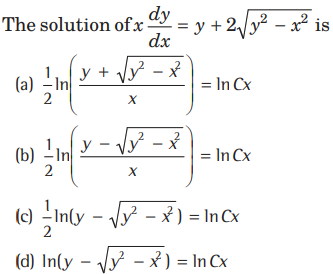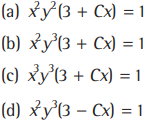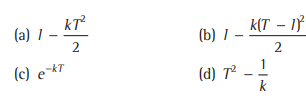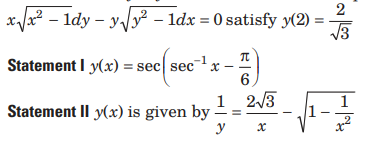MCQs for Mathematics Class 12 with Answers Chapter 9 Differential Equations
Students of class 12 Mathematics should refer to MCQ Questions Class 12 Mathematics Differential Equations with answers provided here which is an important chapter in Class 12 Mathematics NCERT textbook. These MCQ for Class 12 Mathematics with Answers have been prepared based on the latest CBSE and NCERT syllabus and examination guidelines for Class 12 Mathematics. The following MCQs can help you to practice and get better marks in the upcoming class 12 Mathematics examination
Chapter 9 Differential Equations MCQ with Answers Class 12 Mathematics
MCQ Questions Class 12 Mathematics Differential Equations provided below have been prepared by expert teachers of grade 12. These objective questions with solutions are expected to come in the upcoming Standard 12 examinations. Learn the below provided MCQ questions to get better marks in examinations.
Question. The degree of the differential equation x2(d2y/dx2) = (x dy/dx -y)3 is
(a) 1
(b) 2
(c) 3
(d) 6
Answer
A
Question.

Answer
A
Question.

Answer
A
Question. The real value of m for which the substitution y= um will transform the differential equation 2x4y dy/dx + y4= 4x6 into a homogeneous equation is
(a) m = 0
(b) m = 1
(c) m =3/2
(d) m =2/3
Answer
C
Question. The function f (x) satisfying the equation

Answer
A
Question. Solution of x dy/dx +y=x2y4 is

Answer
B
Question. Solution of the differential equation dx/x +dy/y =0 is
(a) 1/x+1/y=c
(b) log x. log y = c
(c) xy = c
(d) x + y = c
Answer
C
Question. Differential equation which has solution of the form y = Acosax + Bsinax , where A and B are arbitrary constants is
(a) d2y/dx2 -α2y = 0
(b) d2y/dx2 + α2y = 0
(c) d2y/dx2 + αy = 0
(d) d2y/dx2 – αy = 0
Answer
B
Question. The degree of the differential equation d2y/dx2 +3(dy/dx)2 =x2log(d2y/dx2)is
(a) 1
(b) 2
(c) 3
(d) Not defined
Answer
D
Question. The order and degree of differential equation [1+(dy/dx)2]2 = d2y/dx2 respectively, are
(a) 1, 2
(b) 2, 2
(c) 2, 1
(d) 4, 2
Answer
C
Question. The solution of the differential equation 2x.dy/dx – y = 3 represents a family of
(a) straight lines
(b) circles
(c) parabolas
(d) ellipses
Answer
C
Question. A solution of the differential equation (dy/dx)2 -xdy/dx +y=0 is
(a) y = 2
(b) y = 2x
(c) y = 2x – 4
(d) y = 2×2 – 4
Answer
C
Question. The number of solution of dy/dx =y+1/y-1 when y(1) = 2 is
(a) none
(b) one
(c) two
(d) infinite
Answer
B
Question. Which of the following is not a homogeneous function of x and y?
(a) x2 + 2xy
(b) 2x – y
(c) cos2(y/x)+y/x
(d) sin x – cos y
Answer
D
Question. The solution of the differential equation xdy/dx + 2y = x2 is
(a) y=x2+C/4x2
(b) y=x2/4+C
(c) y=x2+C/x2
(d) y=x2+C/4x2
Answer
D
Question. The degree of the differential equation (d2y/dx2)2 + (dy/dx)2 = xsin(dy/dx) is
(a) 1
(b) 2
(c) 3
(d) Not defined
Answer
D
Question. The order and degree of a differential equation d2y/dx2+(dy/dx)1/4 +x1/5=0,respectively are
(a) 2 and not defined
(b) 2 and 2
(c) 2 and 3
(d) 3 and 3
Answer
A
Question. The order of the differential equation of all circles of given radius a is
(a) 1
(b) 2
(c) 3
(d) 4
Answer
C
Question. If y = e–x (A cos x + Bsinx) , then it is a solution of
(a) d2y/dx2 +2dy/dx =0
(b) d2y/dx2 – 2d2y/dx2 + 2y = 0
(c) d2y/dx2 +2dy/dx + 2y = 0
(d) d2y/dx2+2y=0
Answer
C
Question. Integrating factor of xdy/dx-y = x4 – 3x is
(a) x
(b) log x
(c) 1/x
(d) –x
Answer
D
Question. Solution of dy/dx -y = 1, y(0) = 1 is given by
(a) xy = –ex
(b) xy = –e–x
(c) xy = –1
(d) y = 2ex – 1
Answer
D
Question. The degree of the differential equation [1+(dy/dx)2]3/2 = d2y/dx2 is
(a) 4
(b)3/2
(c) Not defined
(d) 2
Answer
D
Question. Which of the following is a second order differential equation?
(a) (y’)2 + x = y2
(b) y” + y = sinx
(c) y”’ + (y”)2 + y = 0
(d) y’ = y2
Answer
B
Question. The integrating factor of the differential equation dy/dx (xlogx) +y = 2logx is
(a) ex
(b) log x
(c) log(log x)
(d) x
Answer
B
Question. The differential equation of the family of lines passing through the origin is
(a) dy/dx =x
(b) dy/dx =y
(c) xdy/dx-y =0
(d) x+dy/dx =0
Answer
C
Question. The degree of the differential equation (1+dy/dx)3 = (d2y/dx)2 is
(a) 1
(b) 2
(c) 3
(d) 4
Answer
B
Question. The general solution of the differential equation ex dy + (y ex + 2x) dx = 0 is
(a) x e y + x2 = C
(b) x ex + y2 = C
(c) y ex + x2 = C
(d) y e y + x2 = C
Answer
C
Question. The order and degree of the differential equation d4y/dx4 =y + (dy/dx)4 are respectively
(a) 4, 1
(b) 4, 2
(c) 2, 2
(d) 2, 4
Answer
A
Question. The integrating factor of the differential equation x dy/dx – y = 2×2 is
(a) e–x
(b) e–y
(c) 1/x
(d) x
Answer
C
Question. Solution of the differential equation x dy/dx+y =x ex
(a) x y = ex (1 – x) + C
(b) x y = ex (x + 1) + C
(c) x y = ey (y – 1) + C
(d) x y = ex (x – 1) + C
Answer
D
Question. Integrating factor of the differential equation (1- x2)dy/dx – xy = 1 is
(a) –x
(b) x/1 +x2
(c) √(1 -x2)
(d)1/2 log(1-x2)
Answer
C
Question. The population p (t) at time t of a certain mouse species satisfies the differential equation dp(t)/dt=0.5(t)-450. If p(0) = 850, then the time at which the population becomes zero is
(a) 2 log 18
(b) log 9
(c) 1/2 log18
(d) log18
Answer
A
Question. If dy/dx= y+ 3> 0and y(0) = 2,then y(log 2) is equal to
(a) 5
(b) 13
(c) -2
(d) 7
Answer
D
Question. Let l be the purchase value of an equipment and V (t) be the value after it has been used for t years. The value V (t) depreciates at a rate given by differential equation dV (t)/dt=-k(T-t),where k > 0 is a constant and T is the total life in years of the equipment.
Then, the scrap value V (T) of the equipment is

Answer
A
Question. At present, a firm is manufacturing 2000 items. It is estimated that the rate of change of production P with respect to additional number of workers x is given by dP/dx = – 100 12 √x. If the firm employees 25 more workers, then the new level of production of
items is
(a) 2500
(b) 3000
(c) 3500
(d) 4500 C
Answer
C
Question. Consider the differential equation

Answer
D
Assertion and Reason
Each of these question contains two statements : Statement I (Assertion) and Statement II (Reason). Each of these question also has four alternative choices, only one of which is the correct answer. You have to select one of the codes (a),(b), (c) and (d) given below.
(a) Statement I is true, Statement II is true; Statement II is a correct explanation for Statement I.
(b) Statement I is true, Statement II is true; Statement II is not a correct explanation for Statement I.
(c) Statement I is true; Statement II is false.
(d) Statement I is false; Statement II is true.
Question. Let us consider a linear equation dy/dx+ Py = Q

Statement II The integrating factor of given equation

Answer
D
Question. Let a solution y=y(x) of the differential equation

Answer
C
Question. Consider the differential equation

Statement I For any member of this family y →∞ as x→∞
Statement II Any solution of this differential equation is a polynomial of odd degree with positive coefficient of maximum power.
Answer
A
Question. Statement I The elimination of four arbitrary

Statement II Elimination of n arbitrary constants requires in general a differential equation of the nth order.
Answer
A
Question. Statement I The general solution of dy/dx + y=1 yex=ex+C
Statement II The number of arbitrary constants is in the general solution of the differential equation is
equal to the order of differential equation.
Answer
B
Question. Statement I The curve y= Cx2,C be any arbitrary constant, intersects the curves x2+ 2y2=2C right angles.
Statement II As above, curves trace orthogonal trajectories.
Answer
A
Question. Statement I The differential equation of non-vertical lines in a plane is

Statement II The general equation of all non-vertical lines in a planes is ax+ by= 1, where b ≠ 0
Answer
D
Question. Statement I The differential equation y3dy+(x +y)2 dx=0 becomes homogeneous, if we put y2=t
Statement II All differential equation of first order and first degree become homogeneous if we put y= tx
Answer
C
Question. The integrating factor of the differential equation x(dy/dx)+ 2y = x2 is _____________ .
Answer
x2
Question. The number of arbitrary constants in the general solution of a differential equation of order three is _______.
Answer
3
Question. The solution of differential equation cot y dx = x dy is _____________ .
Answer
x = C sec y
Question. The degree of the differential equation 1+(dy/dx)2 = is _____________
Answer
2
Question. The order of the differential equation 3(d2y/dx2)-5(dy/dx)3 +2y =0 is
Answer
2
Question. The number of arbitrary constant (s) in a particular solution of the differential equation tan x dx + tan y dy = 0 is _____________ .
Answer
zero
Question. The solution of the differential equation X(dy/dx)+2y=x2 is_____________ .
Answer
y = x2/4+C x-2
Question. The general solution of the differential equation dy/dx =x2/y2 is___________ .
Answer
x3-y3 =C

We hope the above multiple choice questions for Class 12 Mathematics for Chapter 9 Differential Equations provided above with answers based on the latest syllabus and examination guidelines issued by CBSE, NCERT and KVS are really useful for you. Differential Equations is an important chapter in Class 12 as it provides very strong understanding about this topic. Students should go through the answers provided for the MCQs after they have themselves solved the questions. All MCQs have been provided with four options for the students to solve. These questions are really useful for benefit of class 12 students. Please go through these and let us know if you have any feedback in the comments section.
